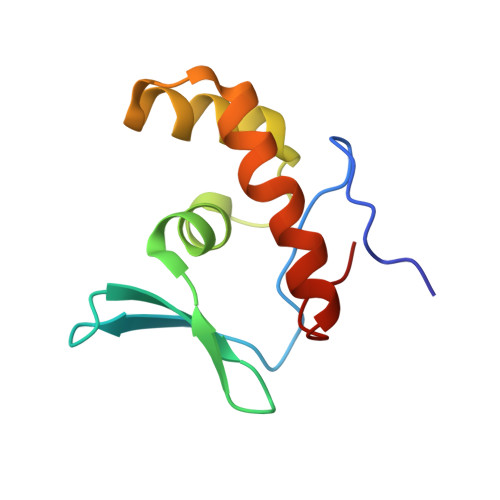Nuclear Magnetic Resonance Structure and Binding Studies of PqqD, a Chaperone Required in the Biosynthesis of the Bacterial Dehydrogenase Cofactor Pyrroloquinoline Quinone.
Evans, R.L., Latham, J.A., Xia, Y., Klinman, J.P., Wilmot, C.M.(2017) Biochemistry 56: 2735-2746
- PubMed: 28481092
- DOI: https://doi.org/10.1021/acs.biochem.7b00247
- Primary Citation of Related Structures:
5SXY - PubMed Abstract:
Biosynthesis of the ribosomally synthesized and post-translationally modified peptide (RiPP), pyrroloquinoline quinone (PQQ), is initiated when the precursor peptide, PqqA, is recognized and bound by the RiPP precursor peptide recognition element (RRE), PqqD, for presentation to the first enzyme in the pathway, PqqE. Unlike other RiPP-producing, postribosomal peptide synthesis (PRPS) pathways in which the RRE is a component domain of the first enzyme, PqqD is predominantly a separate scaffolding protein that forms a ternary complex with the precursor peptide and first tailoring enzyme. As PqqD is a stable, independent RRE, this makes the PQQ pathway an ideal PRPS model system for probing RRE interactions using nuclear magnetic resonance (NMR). Herein, we present both the solution NMR structure of Methylobacterium extorquens PqqD and results of 1 H- 15 N HSQC binding experiments that identify the PqqD residues involved in binding the precursor peptide, PqqA, and the enzyme, PqqE. The reported structural model for an independent RRE, along with the mapped binding surfaces, will inform future efforts both to understand and to manipulate PRPS pathways.
Organizational Affiliation:
Department of Biochemistry, Molecular Biology, and Biophysics and Biotechnology Institute, University of Minnesota, Twin Cities , St. Paul, Minnesota 55108, United States.














